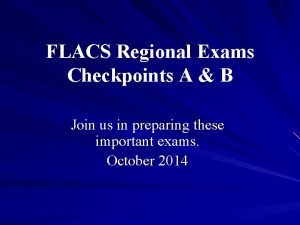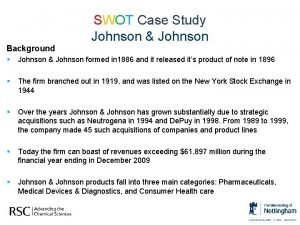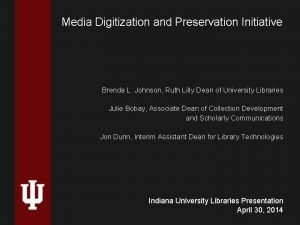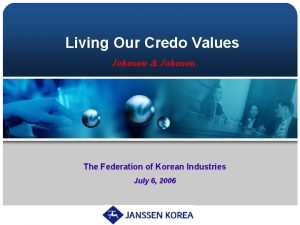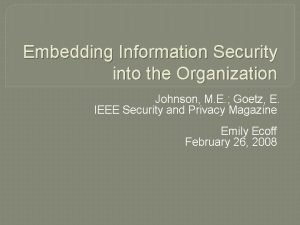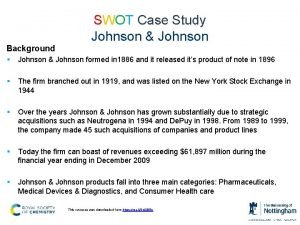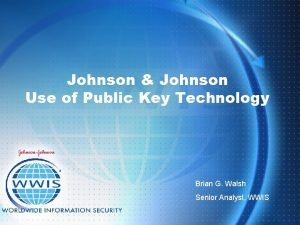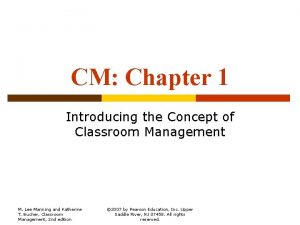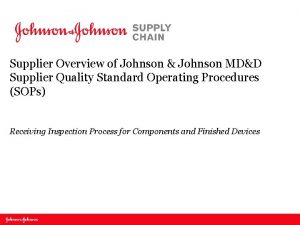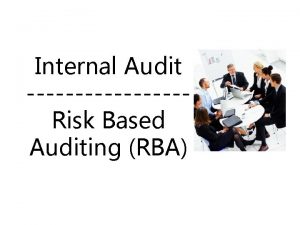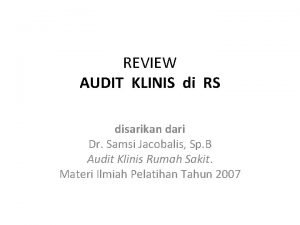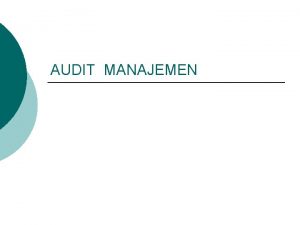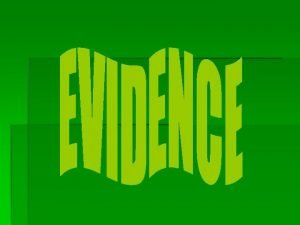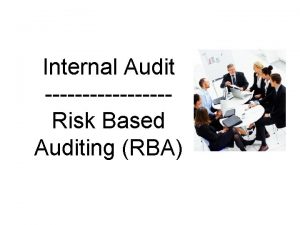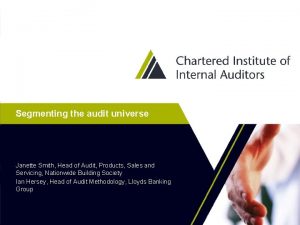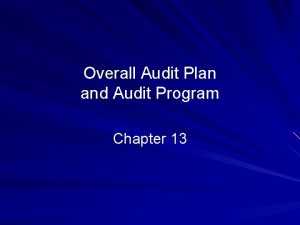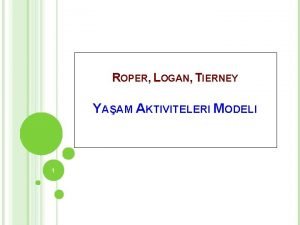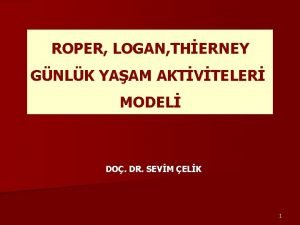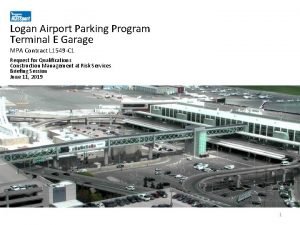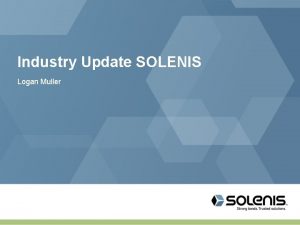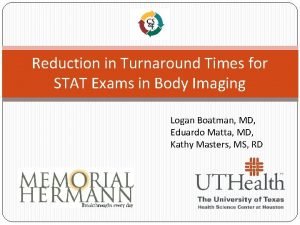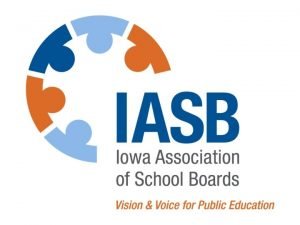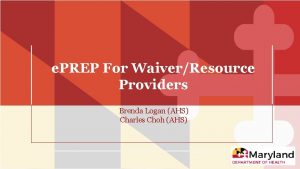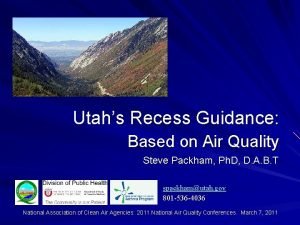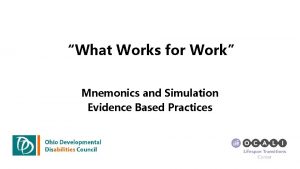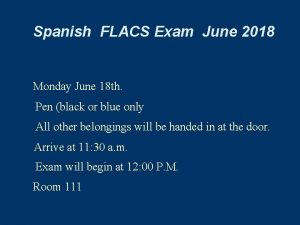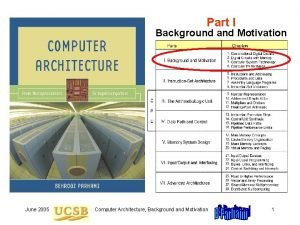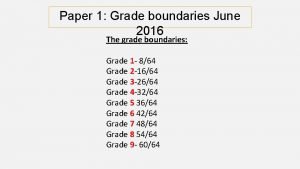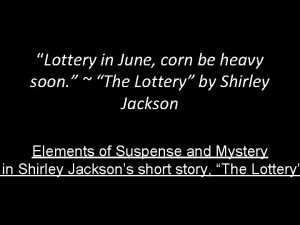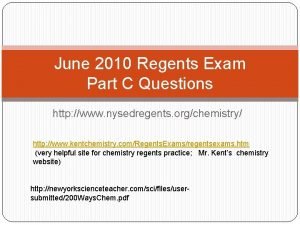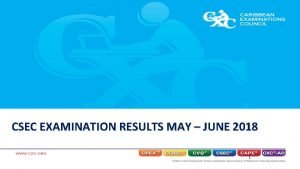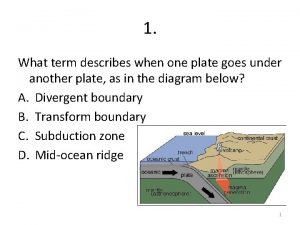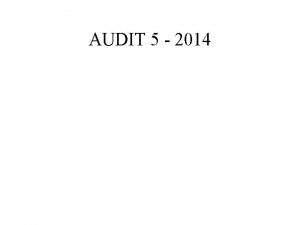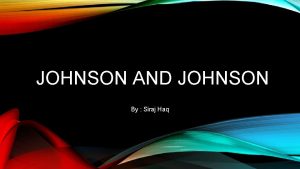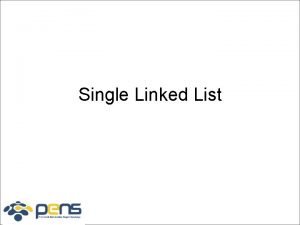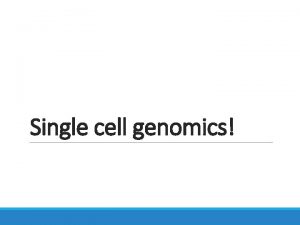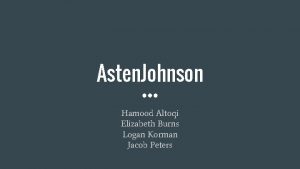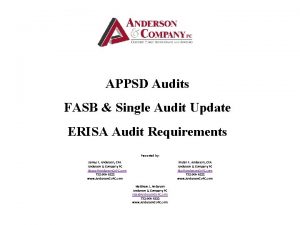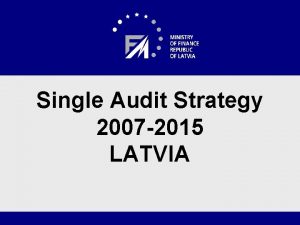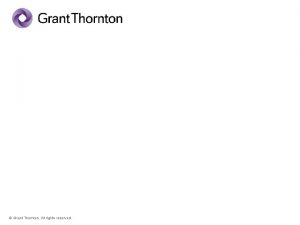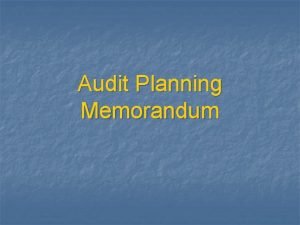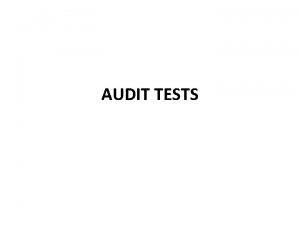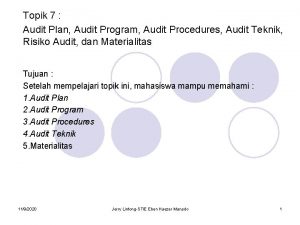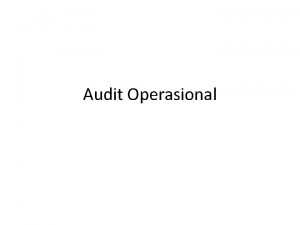Single Audit Logan Thomas Johnson LLC June 2014






































































- Slides: 70

Single Audit Logan, Thomas & Johnson, LLC June 2014 Logan, Thomas & Johnson, LLC www. ltjcpa. com 1

Overview n Who is required to have a Single Audit? n How are programs selected for testing? n Select OMB A-122 Cost Principles Logan, Thomas & Johnson, LLC www. ltjcpa. com 2

Who is required to have a single audit? n The Office of Management and Budget (OMB), pursuant to the Single Audit Act of 1984, requires non -federal entities that expend $500, 000 or more in a year in federal awards to have a single audit. Logan, Thomas & Johnson, LLC www. ltjcpa. com 3

What do I include in determining whether I need a single audit? n All Federal funding such as HUD grants, Part C, vocational grants, CDBG, Head Start, etc. that are received by your organization. Logan, Thomas & Johnson, LLC www. ltjcpa. com 4

What are Federal awards? n Federal award—Federal financial assistance and Federal cost-reimbursement contracts that non-Federal entities receive directly from Federal awarding agencies or indirectly from pass-through entities. n Federal financial assistance—assistance that a non-Federal entity receives or administers in the form of grants, loan guarantees, property, cooperative agreements, interest subsidies, insurance, food commodities, direct appropriations, and other assistance, but does not include amounts received as reimbursement for services rendered. Logan, Thomas & Johnson, LLC www. ltjcpa. com 5

How are programs selected for testing? n Risk-based approach which requires testing of all high-risk Type A programs over $300, 000 or 3% total Federal expenditures (under $100 million) and one-half of the Type B programs over $100, 000 or. 03% total Federal awards. n Total federal expenditure coverage (programs tested) of 50% coverage for a high-risk auditee or 25% coverage for a low-risk auditee. Low-risk auditee evaluation considers findings for preceding 2 years. Logan, Thomas & Johnson, LLC www. ltjcpa. com 6

Determining Grant Requirements n In evaluating the requirements of a grant there are 3 areas you need to review: n n Grant document requirements OMB Circular A-133 Compliance Supplement § General Compliance (Part 3 of A-133) § Specific Compliance (Part 4 of A-133) Logan, Thomas & Johnson, LLC www. ltjcpa. com 7

OMB Circular A-133 - Part 2 n Part 2 of OMB Circular A-133 contains the “Matrix of Compliance Requirements” n There are 14 different types of general compliance requirements that may apply to a grant n Grants are listed by CFDA number Logan, Thomas & Johnson, LLC www. ltjcpa. com 8

OMB Circular A-133 – Part 2 Logan, Thomas & Johnson, LLC www. ltjcpa. com 9

General Compliance Supplement n Required for all grant testing. n Specific areas of requirement as applicable to grant being tested per the Matrix. Logan, Thomas & Johnson, LLC www. ltjcpa. com 10

Specific Compliance Supplement n 19 different Federal Agencies have specific compliance supplements (Part 4 of A-133 Compliance Supplement) n Within each Federal Agency is a listing related to various grants from the Agency Logan, Thomas & Johnson, LLC www. ltjcpa. com 11

Factors affecting allowability n Costs must: n n n n Be reasonable and allocable. Conform to any limitations or exclusions per the award as to types and amounts of cost items. Be consistent with policies and procedures that apply uniformly to both federally-financed and other activities of the organization. Be accorded consistent treatment. Be determined in accordance with generally accepted accounting principles (GAAP). Not be included as a cost or used to meet cost sharing or matching requirements of any other federally-financed program in either the current or a prior period. Be adequately documented! Logan, Thomas & Johnson, LLC www. ltjcpa. com 12

Reasonable Costs n A cost is reasonable if, in its nature or amount, it does not exceed that which would be incurred by a prudent person under the circumstances prevailing at the time the decision was made to incur the costs. n Consideration should be given to: n Whether it is ordinary and necessary for the operation of the organization or performance of the award. n Whether based on sound business practices, arms-length bargaining, compliant with laws and regulations, and meets the terms and conditions of the award. n Whether individuals acted with prudence, considering their responsibilities to the organization, its members, employees, clients, the public and the government. n Significant deviations from the established practices of the organization which may unjustifiably increase the award costs. Logan, Thomas & Johnson, LLC www. ltjcpa. com 13

Allocable Costs n Cost is allocable in accordance with the relative benefits received by the award. Includes: Costs specifically for the award. - DIRECT n Benefits both the award and other work and can be distributed in reasonable proportion to the benefits received by both. – ALLOCATED DIRECT n Is necessary to the overall operation of the organization, although a direct relationship to any particular cost objective cannot be shown. – ALLOCATED INDIRECT n Logan, Thomas & Johnson, LLC www. ltjcpa. com 14

Direct Costs n Direct costs are those that can be identified specifically with a particular final cost objective. n The cost of certain activities are not allowable as charges to Federal awards. See Appendix B. n Allocation of indirect costs may be made for activities which include: 1) the salaries of personnel, 2) occupy space, and 3) benefit from the organization’s indirect costs. Logan, Thomas & Johnson, LLC www. ltjcpa. com 15

Indirect Costs n Indirect costs are those that have been incurred for common or joint objectives and cannot be readily identified with a particular final cost objective. n Typical examples of indirect cost for many non-profit organizations may include the costs of operating and maintaining facilities and general administration or general expenses. Logan, Thomas & Johnson, LLC www. ltjcpa. com 16

Indirect Costs (continued) n Indirect costs shall be classified within two broad categories: Facilities—defined as depreciation and use allowances on buildings, equipment and capital improvement, interest on debt associated with certain capital items, and operations and maintenance expense. n Administration—general administration and general expenses such as the director’s office, accounting, personnel, library expenses and other types of expenses not under another category. n Logan, Thomas & Johnson, LLC www. ltjcpa. com 17

Allocation of Indirect Costs n General – Methods of Allocation n SIMPLIFIED ALLOCATION METHOD—Where a nonprofit organization has only one major function, encompassing a number of individual projects or activities, or all functions benefit by approximately the same degree. n MULTIPLE ALLOCATION BASE METHOD—Where an organization has several major functions which benefit from its indirect costs in varying degrees, allocation of indirect costs may require the accumulation of such costs into separate cost groupings which then are allocated individually to benefiting functions by means of a base which best measures the relative degree of benefit. (# employees in a department, square feet used by activity, other as appropriate) Logan, Thomas & Johnson, LLC www. ltjcpa. com 18

Allocation of Indirect Costs (continued) n Simplified allocation method = n n 1. Separate direct and indirect costs 2. Divide the total indirect costs (net of credits) by an equitable distribution base (indirect cost rate). n Both the direct and indirect costs shall exclude capital expenditures and unallowable costs. n Distribution base may be total direct costs (excluding capital expenditures and other distorting items), direct salaries and wages, or other based which results in an equitable distribution. Logan, Thomas & Johnson, LLC www. ltjcpa. com 19

Allocation of Indirect Costs (continued) n Multiple allocation base method n General—Where an organization’s indirect costs benefit its major functions in varying degrees, indirect costs shall be accumulated into separate cost groupings. Each grouping shall then be allocated individually to benefiting functions by means of a base which best measures the relative benefits. n Identification of indirect costs—Cost groupings shall be established so as to permit the allocation of each grouping on the basis of benefits provided to the major functions. n n Depreciation and use allowances—see Attachment B. Interest—see Attachment B. Operation and maintenance expenses—costs that have been incurred for the administration, operation, maintenance, preservations, and protection of the organization’s physical plant. General administration and general expenses—costs which do not relate solely to any major function of the organization. Logan, Thomas & Johnson, LLC www. ltjcpa. com 20

Allocation of Indirect Costs (continued) n Allocation bases—the essential consideration in selecting a method or a base is that it is the one best suited for assigning the pool of costs to cost objectives in accordance with benefits derived; a traceable cause and effect relationship; or logic and reason, where neither the cause nor the effect are determinable. n Depreciation or use allowances on buildings, capital improvements, and equipment: n n Single function use—assigned to that function More than one function—allocated to individual functions performed in each building on the basis of usable square feet of space, excluding common areas, such as hallways, stairwells, and restrooms. Used jointly by more than one function—allocated on the basis of FTEs or salaries and wages of those individual functions benefiting from use of that space. Depreciation or use allowances on certain capital improvements to land, such as paved parking areas, fences, sidewalks, and the like, not included in the cost of buildings, shall be allocated to user categories on a FTE basis and distributed to major functions in proportion to the salaries and wages of all employees applicable to the functions. Logan, Thomas & Johnson, LLC www. ltjcpa. com 21

Allocation of Indirect Costs (continued) n Allocation bases (continued)— n Interest costs shall be allocated in the same manner as the depreciation or use allowances on the buildings, equipment and capital equipment to which the interest relates. n Operation and maintenance expenses shall be allocated in the same manner as the depreciation and use allowances. n General administration and general expenses shall be allocated to benefiting functions based on modified total direct costs. Logan, Thomas & Johnson, LLC www. ltjcpa. com 22

Allocation of Indirect Costs (continued) n Indirect Costs - Order of Distribution 1. 2. 3. 4. 5. Depreciation and use allowances Interest Operation and maintenance General administration and general expense Other—in the order determined to be most appropriate by the organization Logan, Thomas & Johnson, LLC www. ltjcpa. com 23

Direct Allocation Method n Some non-profit organizations treat all costs as direct costs except general administration and general expense. n These organizations generally separate their costs into three basic categories: 1. 2. 3. n General administration and general expenses Fundraising Other direct functions Joint costs, such as depreciation, rental costs, operation and maintenance of facilities, telephone expenses, and the like are prorated individually as direct costs to each category and to each award or other activity using a base most appropriate to the particular cost being prorated. Logan, Thomas & Johnson, LLC www. ltjcpa. com 24

Direct Allocation Method (continued) n This method is acceptable, provided each joint cost is prorated using a base which accurately measures the benefits provided to each award or other activity. n n n The bases MUST be established in accordance with REASONABLE criteria, AND be SUPPORTED BY CURRENT DATA. Under this method, indirect costs consist exclusively of general administration and general expenses. When a particular segment of work is performed in an environment which appears to general a significantly different level of indirect costs, provisions should be made for a separate indirect cost pool applicable to such work. Logan, Thomas & Johnson, LLC www. ltjcpa. com 25

Attachment B – Allowability of Costs n The following provide selected principles believed to be most pertinent to you (see Attachment B for all) to be applied in establishing the ALLOWABILITY of certain items of cost. n n These principles apply whether a cost is treated as direct or indirect. Failure to mention a particular item of cost is NOT intended to imply that it is unallowable; rather, determination as to allowability in each case should be based on the treatment or principles provided for similar or related items of cost. Logan, Thomas & Johnson, LLC www. ltjcpa. com 26

Audit costs and related services n The costs of audits required by, and performed in accordance with, the Single Audit Act, are allowable. Other audit costs are allowable if included in an indirect cost rate proposal, or if specifically approved by the awarding agency as a direct cost to an award. n The costs of agreed-upon procedures engagements to monitor subrecipients who are exempted from A-133 are allowable. Logan, Thomas & Johnson, LLC www. ltjcpa. com 27

Bad Debts n Bad debts, including losses (whether actual or estimated) arising from uncollectible accounts and other claims, related collection costs and related legal costs, are UNALLOWABLE. Logan, Thomas & Johnson, LLC www. ltjcpa. com 28

Compensation for personal services n A. Definition—Compensation for personal services includes all compensation paid currently or accrued by the organization for services of employees rendered during the period of the award. It includes, but is not limited to, salaries, wages, director’s and executive committee member’s fees, incentive awards, fringe benefits, pension plan costs, allowances for off-site pay, incentive pay, location allowances, hardship pay, and cost of living differentials. Logan, Thomas & Johnson, LLC www. ltjcpa. com 29

Compensation for personal services (continued) n B. Allowable to the extent that: n Total compensation to individual employees is reasonable for the services rendered and conforms to the established policy of the organization consistently applied to both award and non-award activities, AND n Charges to awards whether treated as direct or indirect costs are determined and supported as required in this section. Logan, Thomas & Johnson, LLC www. ltjcpa. com 30

Compensation for personal services (continued) n C. Reasonableness— n Organization activities predominantly other than award—deemed reasonable to the extent compensation is consistent with that paid for similar work in the organization’s other activities. n Organization is predominantly engaged in awardsponsored activities and in cases where the kind of employees required for the award activity are not found in the organization’s other activities— compensation for employees on award-sponsored work will be considered reasonable to the extent that it is comparable to that paid for similar work in the labor markets in which the organization competes for the kind of employees involved. Logan, Thomas & Johnson, LLC www. ltjcpa. com 31

Compensation for personal services (continued) n D. Special considerations in determining allowability. n Compensation to members of non-profit organizations, trustees, directors, associates, officers or the immediate families thereof should be reasonable for the actual personal services rendered rather than a distribution of earnings in excess of costs. n Any change in an organization’s level of compensation, particularly when it was concurrent with an increase in the ratio of the award to other activities or any change in the treatment of allowability of specific types of compensation should be evaluated for reasonableness. Logan, Thomas & Johnson, LLC www. ltjcpa. com 32

Compensation for personal services (continued) n E. Unallowable Costs n Costs which are unallowable under other paragraphs of this Attachment shall not be allowable under this paragraph solely on the basis that they constitute personal compensation. Logan, Thomas & Johnson, LLC www. ltjcpa. com 33

Compensation for personal services (continued) n F. Overtime, extra-pay shift, and multi-shift premiums are allowable only with prior approval except (also allowable): n n When necessary to cope with emergencies. When employees are performing indirect functions, such as administration, maintenance, or accounting. In the performance of tests, laboratory procedures, or other similar operations which are continuous in nature and cannot reasonably be interrupted or otherwise completed. When lower overall cost to the award will result. Logan, Thomas & Johnson, LLC www. ltjcpa. com 34

Compensation for personal services (continued) n G. Fringe Benefits n n Regular compensation paid during periods of authorized absences from the job, such as vacation leave, sick leave, military leave, and the like, are allowable, provided they are absorbed in proportion to the relative amount of time or effect actually devoted to each activity. Employer contributions or expenses for social security, employee insurance, workmen’s compensation insurance, pension plan costs, and the like are allowable, provided they are in accordance with established written organization policies. Logan, Thomas & Johnson, LLC www. ltjcpa. com 35

Compensation for personal services (continued) n G. Fringe Benefits (continued) n n n Provisions for a reserve under a self-insurance program for unemployment compensation or workers’ compensation are allowable to extent that the provisions represent reasonable estimates of the liabilities for such compensation, and the types of coverage, extent of coverage, and rates and premiums would have been allowable had insurance been purchased to cover the same risks; and the amount shall not exceed the present value of the liability. Also, costs are allowable (if prior approval) where the organization has a consistent policy of expensing actual payments to, or on behalf of, employees or former employees for unemployment or workers’ compensation provided they are allocated to all activities. Costs of insurance on the lives of trustees, officers, or other employees holding positions of similar responsibility are allowable only to the extent that the insurance represents additional compensation. The costs of such insurance when the organization is named as beneficiary are unallowable. Logan, Thomas & Johnson, LLC www. ltjcpa. com 36

Compensation for personal services (continued) n H. Organization-furnished automobiles n That portion of the cost that relates to personal use by employees (including transportation to and from work) is unallowable regardless of whether the cost is reported as taxable income to the employee. These costs are allowable as direct costs to the award when necessary for performance of the award and approved by the awarding agency. Logan, Thomas & Johnson, LLC www. ltjcpa. com 37

Compensation for personal services (continued) n I. Pension Plan Costs n Pension plan costs incurred in accordance with established policies are allowable, provided such policies: n n n meet the test of reasonableness methods of cost allocation are not discriminatory cost assigned to each fiscal year is determined in accordance with GAAP costs assigned to a given fiscal year are funded for all plan participants within 6 months after year-end Pension plan termination insurance premiums paid pursuant to ERISA are allowable. Late charges are unallowable. Excise taxes on accumulated funding deficiencies and other penalties imposed under ERISA are unallowable. Logan, Thomas & Johnson, LLC www. ltjcpa. com 38

Compensation for personal services (continued) n J. Incentive Compensation n Incentive compensation to employees based on cost reduction, or efficient performance, suggestion awards, safety awards, etc. , are allowable to the extent that the overall compensation is determined to be reasonable and such costs are paid or accrued pursuant to an agreement entered into in good faith between the organization and the employees before the services were rendered, or pursuant to an established plan followed by the organization so consistently as to imply, in effect, an agreement to make such payment. Logan, Thomas & Johnson, LLC www. ltjcpa. com 39

Compensation for personal services (continued) n K. Severance Pay n Allowable only to the extent that in each case, it is required: n n n by law, employer-employee agreement, established policy that constitutes, in effect, an implied agreement on the organization’s part, or circumstances of the particular employment Actual normal turnover severance payments shall be allocated to all activities. Abnormal or mass severance pay is of such a conjectural nature that measurement of costs by means of an accrual will not achieve equity to both parties and are NOT allowable. Logan, Thomas & Johnson, LLC www. ltjcpa. com 40

Compensation for personal services (continued) n K. Severance Pay (continued) n Costs incurred in certain severance pay packages (commonly known as “a golden parachute” payment) which are in an amount in excess of the normal several pay paid by the organization to an employee upon termination of employment and are paid to the employee contingent upon a change in management control over, or ownership of, the organization’s assets are unallowable. n L. Training costs—see slide 65. Logan, Thomas & Johnson, LLC www. ltjcpa. com 41

Compensation for personal services (continued) n M. Support of Salaries and Wages n 1. Charges to awards for salaries and wages, whether treated as direct costs or indirect costs, will be based on documented payrolls approved by a responsible official of the organization. n The distribution of salaries and wages to awards MUST be supported by personnel activity reports (time sheets), as prescribed in the next paragraph, except when a substitute system has been approved in writing by the cognizant agency. Logan, Thomas & Johnson, LLC www. ltjcpa. com 42

Compensation for personal services (continued) n M. Support of Salaries and Wages (continued) n 2. Reports reflecting the distribution of activity of each employee MUST be maintained for ALL staff members (professionals and nonprofessionals) whose compensation is charged, in whole or in part, directly to awards. n In addition, in order to support the allocation of indirect costs, such reports must also be maintained for other employees whose work involves two or more functions or activities if a distribution of their compensation between such functions or activities is needed in the determination of the organization’s indirect cost rate. (continued) Logan, Thomas & Johnson, LLC www. ltjcpa. com 43

Compensation for personal services (continued) n M. Support of Salaries and Wages (continued) n 2 (continued) Reports maintained by non-profit organizations to satisfy these requirements MUST meet the following standards: n n The reports must reflect an after-the-fact determination of the actual activity of each employee. Budget estimates do NOT qualify as support for charges to awards. Each report must account for the total activity for which employees are compensated and which is required in fulfillment of their obligations to the organization. The reports must be signed by the individual employee, or by a responsible supervisory official having first hand knowledge of the activities performed by the employee, that the distribution of activity represents a reasonable estimate of the actual work performed by the employee during the periods covered by the reports. The reports must be prepared at least MONTHLY and must coincide with one or more pay periods. Logan, Thomas & Johnson, LLC www. ltjcpa. com 44

Compensation for personal services (continued) n M. Support of Salaries and Wages (continued) n 3. Charges for the salaries and wages of nonprofessional (nonexempt) employees, in addition to the supporting documentation described above, must also be supported by records indicating the total number of hours worked each day maintained in conformance with DOL regulations implementing the Fair Labor Standards Act. Logan, Thomas & Johnson, LLC www. ltjcpa. com 45

Compensation for personal services (continued) n M. Support of Salaries and Wages (continued) n 4. Salaries and wages of employees used in meeting cost sharing or matching requirements on awards must be supported in the same manner as salaries and wages claimed for reimbursement from awarding agencies. Logan, Thomas & Johnson, LLC www. ltjcpa. com 46

Contingency Provisions n Contributions to a contingency reserve or any similar provision made for events the occurrence of which cannot be foretold with certainty as to time, intensity, or with an assurance of their happening, are unallowable. This excludes self-insurance reserves, pension funds, and reserves for normal severance pay discussed previously. Logan, Thomas & Johnson, LLC www. ltjcpa. com 47

Depreciation and use allowances n A. Combination of depreciation and use allowance methods is NOT allowed. n B. Shall be based on acquisition costs or FMV at time of donation. n C. Basis will exclude cost of land, any portion borne by the Federal government, and any portion contributed in satisfaction of a statutory matching requirement. Logan, Thomas & Johnson, LLC www. ltjcpa. com 48

Depreciation and use allowances (continued) n D. Depreciation Method n n Useful life should consider the quality, nature of use, technological developments in the particular area, renewal and replacement policies for the asset category, and shall reflect the pattern of consumption of the asset during its life. In the absence of clear evidence indicating otherwise, the straight-line method shall be presumed to be the appropriate method. Depreciation methods once used shall not be changed unless approved in advance. Total depreciation or use allowance for the asset MUST NOT exceed the total acquisition cost of the asset. Logan, Thomas & Johnson, LLC www. ltjcpa. com 49

Depreciation and use allowances (continued) n E. When the depreciation method is used for buildings, a building’s shell may be segregated from each building component (e. g. , plumbing system, heating, and airconditioning system, etc. ) and each item depreciated over its estimated useful life, n or the entire building (i. e. , the shell and all components) may be treated as a single asset and depreciated over the useful life. n Logan, Thomas & Johnson, LLC www. ltjcpa. com 50

Depreciation and use allowances (continued) n F. Where the depreciation method is used for a class of assets, no depreciation is allowed on fully depreciated assets. n G. Where the use allowance method is followed: n n n The use allowance for buildings and improvements (such as parking areas, fences, and sidewalks) will be computed at an annual rate NOT exceeding 2% of acquisition cost. The use allowance for equipment will not exceed 6 2/3% of acquisition costs. The entire building must be treated as a single asset. n H. Charges for use allowance or depreciation MUST be supported by adequate property records and physical inventories MUST be taken at least once every two years to ensure that assets exit and are usable and needed. Logan, Thomas & Johnson, LLC www. ltjcpa. com 51

Employee morale, health, and welfare costs n The costs of publications, activities or counseling in accordance with the organization’s policy for improvement of working conditions, employer-employee relations, employee morale, and employee performance are allowable and apportioned to all activities of the organization. Logan, Thomas & Johnson, LLC www. ltjcpa. com 52

Equipment and other capital expenditures n A. Definitions n n n Capital expenditures—expenditures for the acquisition cost of capital assets or expenditures to make improvements to capital assets that materially increase their value or useful life. Acquisition cost—the cost of the asset including the cost to put it in place, including any modifications, attachments, accessories, or auxiliary apparatus necessary to make it usable for the purpose for which is was acquired. Equipment—nonexpendable, tangible personal property having a useful life of more than 1 year and acquisition cost of the lesser of the organization’s capitalization policy or $5, 000. Logan, Thomas & Johnson, LLC www. ltjcpa. com 53

Equipment and other capital expenditures (continued) n B. Allowability n n n Capital expenditures for general purpose equipment, buildings, and land are unallowable as DIRECT charges, except where approved in advance. Capital expenditures for special purpose equipment are allowable as direct costs, provided that items have a unit cost of $5, 000 or more and prior approval of the awarding agency. Capital expenditures for improvements to land, buildings, or equipment which materially increase their value or useful life are unallowable as a direct cost except with prior approval. Must be charged to the period incurred. Equipment and other capital expenditures are unallowable as indirect costs. See depreciation and use allowance. CANNOT charge the equipment directly and depreciation or use allocation on that same equipment. Logan, Thomas & Johnson, LLC www. ltjcpa. com 54

Gains and losses on depreciable assets n Gains and losses on sale, retirement or other disposition of depreciable property is allowable in the year in which they occur unless resulting from exchange transaction or failure to maintain permissible insurance. Logan, Thomas & Johnson, LLC www. ltjcpa. com 55

Insurance and indemnification n Costs of insurance required or approved pursuant to the award are allowable. n Costs of other insurance in connection with the general conduct of its operations are allowable subject to the following limitations: n n Types and extent of coverage shall be in accordance with sound business practice and the rates and premiums shall be reasonable under the circumstances. Exclude coverage of management fees. Any provisions for a reserve covering risk of loss or damage are allowable to extent the organization is liable for such loss or damage. Provisions for a reserve under a self-insurance program are allowable to the extent that types of coverage, extent of coverage, rates, and premiums would have been allowed had insurance been purchased to cover the risks. Costs, which are not payable for more than one year after the provision is made, shall not exceed the present value of the liability. Logan, Thomas & Johnson, LLC www. ltjcpa. com 56

Insurance and indemnification (continued) n Costs of insurance on the lives of trustees, officers, or other employees holding positions of similar responsibilities are allowable only to the extent that the insurance represents additional compensation. If the organization is the beneficiary, the cost is unallowable. n Actual losses which could have been covered by permissible insurance are unallowable unless expressly provided for in the award unless due to nominal deductible in keeping with sound business practice or minor losses not covered which occur in the ordinary course of operations. n Indemnification is allowable only to extent expressly provided in the award. Logan, Thomas & Johnson, LLC www. ltjcpa. com 57

Interest n Costs incurred for interest on borrowed capital, temporary use of endowment funds, or the use of the organization’s own funds are unallowable. n Interest on debt incurred after 9/29/95 to acquire or replace capital assets and used in support of the award is allowable, provided that: n n The organization (prior to acquisition) prepares a lease/purchase analysis which shows that a financed purchase or capital lease is less costly than other leasing alternatives on a net present value basis. Interest rates are no higher than FMV (arm’s length trxn). Investment earnings from borrowed funds are used to offset allowable interest costs. Reimbursements are limited to the least costly alternative based on the total cost analysis. Logan, Thomas & Johnson, LLC www. ltjcpa. com 58

Interest (continued) n Interest on debt incurred to finance or refinance assets acquired before or reacquired after 9/29/95 is not allowable. n Interest attributable to fully depreciated assets is unallowable. n Additional requirements for debt arrangements over $1 million, substantial relocation of program activities, and organizations subject to 48 CFR 9903—see Attachment B details. Logan, Thomas & Johnson, LLC www. ltjcpa. com 59

Losses on other awards n Any excess costs over income on any award is unallowable as a cost of any other award. Logan, Thomas & Johnson, LLC www. ltjcpa. com 60

Maintenance and repair costs n Costs incurred for necessary maintenance, repair, or upkeep of buildings and equipment which neither add to the permanent value of the property nor appreciably prolong its intended life, but keep it in an efficient operating condition, are allowable. Logan, Thomas & Johnson, LLC www. ltjcpa. com 61

Materials and supplies costs n Costs incurred for materials and supplies necessary to carry out an award are allowable. n Purchased materials and supplies shall be charged at their actual price, net of applicable credits. n Withdrawals from stockrooms should be charged at their actual net cost under any recognized method of pricing inventory withdrawals, consistently applied. Logan, Thomas & Johnson, LLC www. ltjcpa. com 62

Meetings and conferences n Costs of meetings and conferences, the primary purpose of which is the dissemination of technical information, are allowable. This includes the costs of meals, transportation, rental of facilities, speakers’ fees, and other incidental items not designated as unallowable in other sections. Logan, Thomas & Johnson, LLC www. ltjcpa. com 63

Rental costs of buildings and equipment n Allowable to the extent that the rates are reasonable in light of comparable property, market conditions in the area, alternatives available, and the type, life expectancy, condition, and value of property leased. n Rental costs under “sale and lease back” arrangements are allowable only up to the amount allowed had ownership continued. Logan, Thomas & Johnson, LLC www. ltjcpa. com 64

Training costs n Costs of preparation and maintenance of a program of instruction is allowable. n Costs of part-time secondary education are allowable only when the course or degree pursued is relative to the field in which the employee is now working or may reasonably be expected to work and are limited to materials, textbooks, fees, tuition, instructor costs, and straight-time compensation for time spent attending class. n See Attachment B for additional details. Logan, Thomas & Johnson, LLC www. ltjcpa. com 65

Transportation costs n Includes freight, express, cartage, and postage charges relating either to goods purchased, in process, or delivered are allowable. Logan, Thomas & Johnson, LLC www. ltjcpa. com 66

Travel costs n A. General—transportation, lodging, subsistence, and related items incurred by employees who are in travel status on official business of the organization are allowable based on actual costs, a per diem or mileage basis in lieu of actual costs incurred, or a combination. n Limited to amounts considered reasonable and allowable to the extent they do not exceed charges normally allowed by the organizations’ policy. In the absence of an acceptable, written policy, the rates and amounts established under subchapter I of Chapter 57, Title 5, United States Code or by the Administrator of General Services or by the President …shall apply to the travel under awards. n Airfare costs in excess of coach or equivalent status is unallowable. See Attachment B for details. Logan, Thomas & Johnson, LLC www. ltjcpa. com 67

Resources Logan, Thomas & Johnson, LLC www. ltjcpa. com 68

Resources n OMB Circulars, including A-133 & A-122 n http: //www. whitehouse. gov/omb/circulars/index. ht ml Logan, Thomas & Johnson, LLC www. ltjcpa. com 69

Contacts n Logan, Thomas & Johnson, LLC 5023 W. 120 th Ave. , #165 Broomfield, CO 80020 n n Calvin Logan – clogan@ltjcpa. com, phone 303 -532 -1000, fax 303 -532 -1080 Jan Thomas – jthomas@ltjcpa. com, phone 303 -569 -6030, fax 303 -569 -6031 Pauline Davis – pdavis@ltjcpa. com, phone 719 -640 -1188, fax 719 -937 -4271 Jamie Holland – jholland@ltjcpa. com, phone 719 -266 -2208, fax 719 -266 -2209 Logan, Thomas & Johnson, LLC www. ltjcpa. com 70
 Flacs exam 2020
Flacs exam 2020 Starbucks swot analizi
Starbucks swot analizi Johnson and johnson bcg matrix
Johnson and johnson bcg matrix Brad and laurie johnson
Brad and laurie johnson Credo leadership behaviors
Credo leadership behaviors Johnson and johnson organizational structure
Johnson and johnson organizational structure Johnson and johnson botnet infections
Johnson and johnson botnet infections Johnson and johnson swot analysis
Johnson and johnson swot analysis Jjeds jnj directory
Jjeds jnj directory Johnson and johnson three c's of classroom management
Johnson and johnson three c's of classroom management Johnson and johnson md&d
Johnson and johnson md&d Thomas johnson middle school
Thomas johnson middle school Tawana thomas johnson
Tawana thomas johnson Forensic pathologist vs forensic anthropologist
Forensic pathologist vs forensic anthropologist Perbedaan audit konvensional dengan audit berbasis risiko
Perbedaan audit konvensional dengan audit berbasis risiko Perbedaan audit medis dan audit klinis
Perbedaan audit medis dan audit klinis Beda audit medis dan audit klinis
Beda audit medis dan audit klinis Penyelesaian audit dan tanggung jawab pasca audit
Penyelesaian audit dan tanggung jawab pasca audit Hubungan ekonomisasi efisiensi dan efektivitas
Hubungan ekonomisasi efisiensi dan efektivitas Perbedaan prosedur audit top-down dengan bottom-up
Perbedaan prosedur audit top-down dengan bottom-up Audit definition
Audit definition Perbedaan audit konvensional dengan audit berbasis risiko
Perbedaan audit konvensional dengan audit berbasis risiko The word audit has been derived from the latin word *
The word audit has been derived from the latin word * Audit universe
Audit universe Overall audit plan and audit program
Overall audit plan and audit program 2 cfr 200 single audit
2 cfr 200 single audit Logan high school
Logan high school Roper logan tierney model
Roper logan tierney model 12 yaşam aktivitesi
12 yaşam aktivitesi Logan muller
Logan muller Logan hood
Logan hood Garage mpa
Garage mpa Logan muller
Logan muller Lars didn't recognize patrick logan because
Lars didn't recognize patrick logan because Cassie logan character traits
Cassie logan character traits Logan boatman, md
Logan boatman, md Parental alienation
Parental alienation Annie gunner logan
Annie gunner logan Cloning pros and cons
Cloning pros and cons Kahoot it
Kahoot it Operation market garden
Operation market garden Logan
Logan Kathmandu competitors
Kathmandu competitors Graeme logan scottish government
Graeme logan scottish government Eprep.health.maryland.gov
Eprep.health.maryland.gov Logan let.an
Logan let.an Bruce logan penn state
Bruce logan penn state Greenville elementary logan utah
Greenville elementary logan utah Logan olsen
Logan olsen Sisd in computer architecture
Sisd in computer architecture Single instruction single data
Single instruction single data Waiting line management
Waiting line management 30 days has september
30 days has september Flacs checkpoint b spanish exam june 2018 answers
Flacs checkpoint b spanish exam june 2018 answers June 2007 physics regents answers
June 2007 physics regents answers June 2005 calendar
June 2005 calendar When your child leaves home poem
When your child leaves home poem Good morning 1 june
Good morning 1 june Corn be heavy soon
Corn be heavy soon June 2010 chemistry regents answers
June 2010 chemistry regents answers Welcome june blessings
Welcome june blessings Summary period: june 2021 jack
Summary period: june 2021 jack Grade 7 life orientation term 1 notes
Grade 7 life orientation term 1 notes Good morning welcome june
Good morning welcome june June 2019 geometry regents answers
June 2019 geometry regents answers June 2015 flacs exam answers
June 2015 flacs exam answers Cxccxc results 2018
Cxccxc results 2018 Britney spears
Britney spears School is out by lenore hetrick
School is out by lenore hetrick June cheetah wegener
June cheetah wegener Symbolism in the lottery
Symbolism in the lottery
